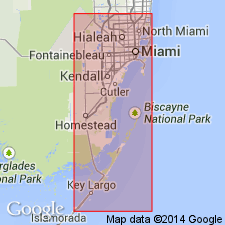
- Usage in publication:
-
- Key Largo limestone
- Modifications:
-
- Named
- Dominant lithology:
-
- Limestone
- AAPG geologic province:
-
- South Florida province
Summary:
Kay Largo limestone, here named, is extremely variable in appearance and structure, being solid limestone of coral origin, in some parts a coral conglomerate, over much larger areas a fine white limestone. It is often free from any proofs of an organic origin. It breaks with a conchoidal fracture, a splintery surface, and rings under the hammer. Other portions are made of standing corals with the intervals filled in by reef debris and the whole cemented solid. In places the rock is a typical breccia composed of angular and cherty fragments in a limy cement, the cement and many of the fragments being bright red. Thickness, judged from well records, 69 to 130 ft. This limestone represents only known fossil coral reef in southern FL. In places the Key West oolite apparently rests on Key Largo limestone; the relations to Miami oolite and Lostmans River limestone are less certain.
Source: GNU records (USGS DDS-6; Reston GNULEX).

- Usage in publication:
-
- Key Largo Limestone
- Modifications:
-
- Revised
- AAPG geologic province:
-
- Florida platform
Summary:
Hialeah Group (DuBar, in press) is composed of the late Pleistocene Fort Thompson Formation, Anastasia Formation, Miami Limestone, and Key Largo Limestone. Formations intergrade and interfinger, especially in southeastern FL. Key Largo is a fossil coral reef that forms the Florida Keys from Soldier Key southwest to New Found Harbor Channel. Extends in subsurface from Miami Beach southwestward to Dry Tortugas. Upper part of Key Largo is the same age as the Miami Limestone. Coral from Windley Key Quarry dated at 139 ka (Th230/U234) by Harmon and others (1979).
Source: GNU records (USGS DDS-6; Reston GNULEX).
For more information, please contact Nancy Stamm, Geologic Names Committee Secretary.
Asterisk (*) indicates published by U.S. Geological Survey authors.
"No current usage" (†) implies that a name has been abandoned or has fallen into disuse. Former usage and, if known, replacement name given in parentheses ( ).
Slash (/) indicates name conflicts with nomenclatural guidelines (CSN, 1933; ACSN, 1961, 1970; NACSN, 1983, 2005, 2021). May be explained within brackets ([ ]).

